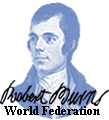


 |
 |
 |
100 BURNS FACTS
THE
FIRST EDINBURGH EDITION
(Facts
45-50)


Revd
George Lawrie

46. The first review of the Kilmarnock Poems appeared in the "Edinburgh Magazine" of October 1786, anonymously but probably written by James Sibbald. The most important review was in "The Lounger" of 9 December 1786, written by Henry Mackenzie who enthused over the "uncommon penetration and sagacity of this Heaven-taught ploughman, from his humble and unlettered station" - thus creating the myth which Burns played up for all it was worth.
47. The first poem of Burns to make its debut in a newspaper was 'Address
to a Haggis' which appeared in the "Caledonian Mercury" on 20 December
1786. Contrary to popular belief, haggis was not a traditional dish; it was
a novelty whose recipe was first published earlier that year, in "Cookery
and Pastry" by Susanna MacIver.

48. Within a week of his arrival, Burns was lionised by society and the literati.
The Earl of Glencairn persuaded his former tutor William Creech to publish
a new, enlarged edition. The Earl also ensured that the book got a good send-off
by persuading the Caledonian Hunt to subscribe "en bloc", a matter
which Burns duly acknowledged in his fulsome dedication. About 1500 people
subscribed for 2876 copies at five shillings each.
The Earl of Glencairn


William Creech
50. The first Edinburgh Edition was published on 17 April 1787. That evening,
Burns sold his rights to Creech for 100 guineas (£105), on the advice
of Henry Mackenzie. Burns did not get paid till 30 May 1788, a matter that
kept him hanging around Edinburgh many months longer than he had intended.
In fact Burns had already assigned the rights in the Kilmarnock edition to
his brother Gilbert (two-thirds of the present volume). The view that Burns
virtually gave away his work is unfounded: £105 in 1787 would be worth
approx £30,000 today. In addition, from the sales of the first Edinburgh
edition Burns obtained about £1000, less production costs of £200
- £250, a net profit to the author of at least £750 and substantially
more than the £400 he admitted in his Autobiographical Letter to Dr
Moore.